Sam Fisher returns to the fray in the darkest episode of the saga.

After having spoken to you about the magnificent Theory of Chaos, it is today the turn of Splinter Cell: double agent, possibly the game of the series which is furthest from the classical formula. As you may have already guessed, this time Fisher will have to go undercover again, to try to assess and neutralize the terrorist organization EJB (John Brown’s Army)
As the grand story of this title unfolds, we must carefully balance the favor of the NSA (agency division) and EJB choose your actions carefully. We receive objectives from both sides throughout each mission, many of which took place at EJB headquarters. We also often had to choose one of them over the other, which affected our trust meter. The decisions
when we started Splinter Cell: double agent we have the feeling that Fisher was a good guy and always would be.. All he had to do was just complete his mission and he would never become a villain. However, curiously the game allowed you to do just that if you wanted to, which went against all the morality we had until now.

The classic gameplay of Burst cell stayed in Double agent, but the game was too much more and more raw th an in other installments. This is likely because Fisher did not have direct NSA support, or at least was limited in maintaining his cover. It gave him a real sense of vulnerability.
In reality, Fisher was very limited as to what he could do and where he could go at EJB headquarters without arousing suspicion. The Stealth Counter was his aid in sneaking into forbidden areas undetected and that was more important than ever as he couldn’t just fire one and walk away as his cover would be blown forever
Altogether this too made Splinter Cell: Double Agent the hardest game in the series. Fisher’s health was regenerating automatically for the first time, which seems helpful, but it didn’t help much when spotted. The classic lock picking mechanic is back, as well as a new minesweeping mini-game, among others.

However, there was a moment that really surprised me. Towards the end of the game (SPOILER ALERT) you are faced with a choice to prove your loyalty to the EJB. You can shoot Jamie Washington (your old cellmate and EJB member) or instead turn your gun around and walk out Irving Lambert of the NSA. A moment that undoubtedly left all fans between a rock and a hard place. Special mention also to spectacular Spanish dubbing section that the game has, something that Ubisoft has always taken great care of.
A strange quirk of Splinter Cell: Double Agent is that two versions have been released, with fundamental differences that oddly reflect (at least structurally) the two different paths you can take in the game itself. The version released for Xbox 360 is, in my opinion, the best both plot-wise and graphically. The other interpretation of the game, often referred to as “Version 2”, was released for the previous generation of consoles, but oddly after “Version 1”. In fact, everything is a bit confusing.
Splinter Cell: Double Agent Wasn’t Afraid to Innovate in 2006, introducing events that would change the series forever. I had a hard time accepting it at first because it came after the fantastic Chaos Theory, which is still my favorite Splinter Cell game. However, if you’re looking for a Sam Fisher experience like no other, it’s worth checking out.








